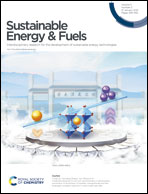Mass transfer characteristics and energy penalty analysis of MEA regeneration process in packed column†
Abstract
The high energy consumption of the MEA regeneration process is the biggest challenge for the application of CO2 capture by the monoethanolamine (MEA) solution. Therefore, it is important to determine the dominating parameters influencing energy consumption and mass transfer performance. In this work, a new model of regeneration process in the stripper is established based on the pseudo-single-liquid and representative elementary volume (REV) method. The profiles of two phase temperatures and all species concentrations are then analyzed using the field synergy theory. Moreover, the mass transfer performance is investigated under multi-working conditions. The results show that the liquid film dominates in the mass transfer process, and the liquid phase significantly influences the specific heat consumption. The energy consumption can be saved by >10% when the liquid flow rate increases from 20 to 50 m3 m−2 h−1 or the increase in liquid inlet temperature from 353.15 to 383.15 K. The energy consumption at an initial MEA concentration of 1 kmol m−3 is extremely high and unacceptable. This work contributes to the mass transfer enhancement and energy saving of the regeneration process of carbon dioxide capture in packed columns.



 Please wait while we load your content...
Please wait while we load your content...